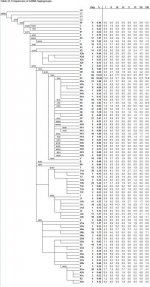I was about to post this, but Zanipolo beat me to it.
Here is the
link to the actual study. The data corresponds very closely to the one I compiled in the Y-DNA tables based on other studies to date. Boattini et al. note that the gradient within Italy is not north-south but rather north-west to south-east + Sardinia, which is exactly what my maps have shown. You can see this most clearly by comparing the
R1 map with the
E+G+J+T map.
The authors confirm that most Y-DNA lineages in Italy appear to date from the Late Neolithic to the Bronze Age. This is the first official study finally acknowledging what I have been saying for many years, namely that R1b and J2, and not just R1a, came to Europe during the Bronze Age and not the Neolithic.
The strong point of this new study is the depth of the subclades tested. The weak point is the sample size, which would be enough for top-level haplogroups, but is much too small to give a reliable image of the distribution of deep subclades. The deeper the level tested and the larger the sample size should be. There are only about 900 individuals for a country of 60 million inhabitants with a very big historical population. This is less than the
Larmuseau et al. study about Flanders which was barely sufficient to show regional disparities at the deep subclade level. Besides the regional diversity in mountainous Italy is far greater than in flat and homogeneous Flanders. I would therefore advise a sample size of
at least 1000 for each of Italy's 20 regions to have a reasonable picture at the deep clade level.
Of interest, though to take with a pinch of salt considering the small sample size.
- The hotspot of
R1b-L21 (10%) is Emilia-Romagna, a region supposedly settled by Celtic people.
- The highest frequency of
R1b-U152 + subclades are found in Tuscany (37.4%), Emilia-Romagna (31%), Piedmont-Lombardy (31%) and Lazio-Umbria-Marche (21%). This roughly correspond to my
R1b-U152 map and is in line with
my hypothesis that U152 represents the Bronze Age Italic people. If U152 were merely Gaulish Celtic it wouldn't peak in Tuscany and would not be so high in Central Italy in general.
- Germanic migrations can be traced back through
R1b-S21, which peaks in Northeast Italy (presumably due to the Langobardi) and Sicily (undeniably because of the Normans).
I1 peaks in Emilia-Romagna (11%) and Northeast Italy (10.3%), but is oddly very low in Lombardy-Piedmont (3.1%) and Sicily (1.4%). I guess that this is due to undersampling. My data from other studies had an average of 3% for Sicily. The strangest results come from I2b1 (M223), which is absent from regions with heavy Germanic settlements like Northeast Italy, but highest in southern Italy (2.4%). Also undersampling, I suppose.
- The regional percentages reported for
R1a are somewhat contradictory with previous studies. It shows no R1a at all in Northeast Italy, which is supposed to be the region with the highest frequency of R1a. On the other hand the percentages for Sicily (5.7%), Tuscany (4.9%), South Italy (4%) and Lazio-Umbria-Marche (3.9%) is a few points higher than expected.
- Unsurprisingly
G peaks in Central Italy (14.3%) and South Italy (16.2%) and is lowest in Northeast Italy (6.8%) and Tuscany (5.7%). On the other hand, the frequency of G appears a bit higher everywhere than in the earlier data.
- Let's note also the very odd 8.2% of
L in Northeast Italy and 6.9% of
J1e in Bologna. The earlier
J1 hotspot in Tuscany is also contradicted by this study, which only found 1.4%.







